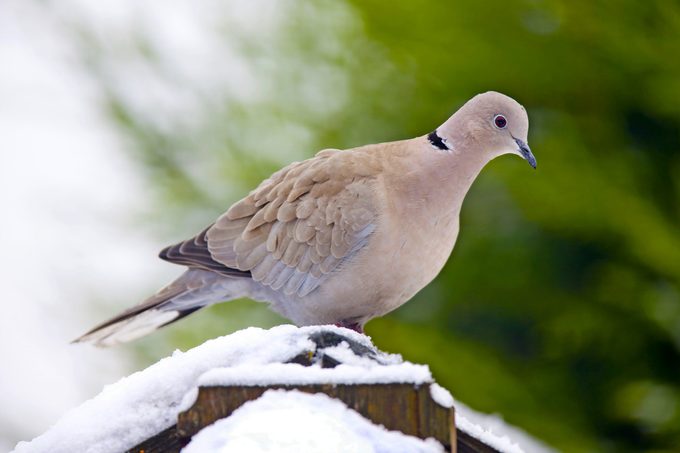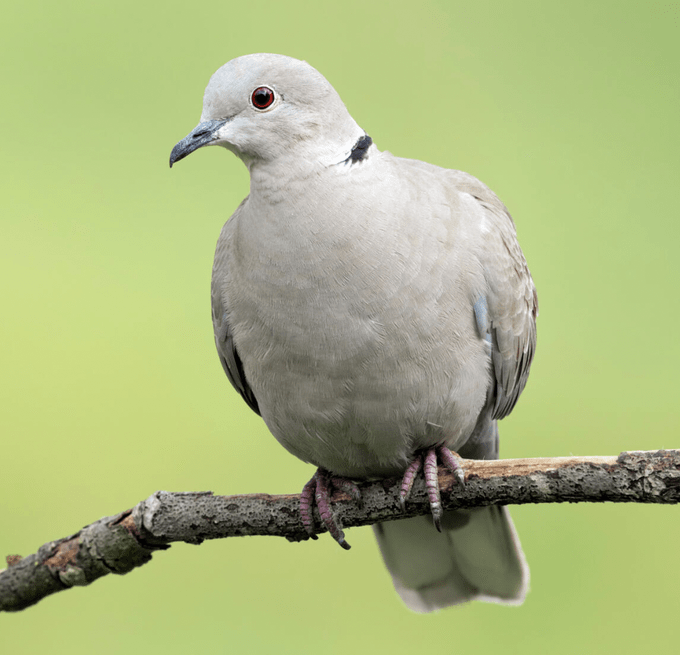How to Identify a Eurasian Collared-Dove
Updated: Feb. 16, 2024
Look for a Eurasian collared-dove at feeders in the western and southern states. Learn what the nonnative bird looks and sounds like.
On This Page
What Do Eurasian Collared-Doves Look Like?

Eurasian collared-doves are sometimes confused with mourning doves. If a thick black band is present on the collar, it’s a collared dove. Although visually similar, Eurasian collared-doves are heftier than mourning doves and have greater wingspans—a difference of about 10 centimeters.
Range
“What’s the difference between the doves with plain gray feathers and the ones with a black ring around the neck?” asks Birds & Blooms reader Wil Bridger of Twin Falls, Idaho.
Birding experts Kenn and Kimberly Kaufman explain, “This reflects a fascinating change in North American bird life. Eurasian collared-doves, the ones with the black rings, are native to Europe and Asia. They escaped in the Bahamas in the 1970s and thrived in the wild there. In the 1980s, some strayed to Florida, where they established a population and began to increase in numbers.
Soon they expanded their range toward the west and north into areas where mourning doves, which are mostly gray, are common. Collared-doves are still scarce in the Northeast and upper Midwest, but they are now common all over the southern and western states. A few reached your area of Idaho around 2005, and they’ve been increasing ever since.”
Great Backyard Bird Count data shows the Eurasian collared-dove has now expanded its range to more than 39 states and into Canada.
There are four predominant dove species found in the Southwest: Eurasian collared-dove, Inca dove, mourning dove and white-winged dove.
Eurasian Collared-Dove Sound
The Eurasian collared-dove’s voice is a “coo-coo-coo” and they also emit a harsh “krreew” when in flight. Do mourning dove feathers and wings make noise?
Bird sounds courtesy of the Cornell Lab of Ornithology.
Diet

Eurasian collared-doves tend to make their homes in urban and suburban areas but stay away from large cities. They are not timid and are tolerant of humans. These doves will visit your bird feeder, mostly feeding on the seed that falls to the ground. They also eat insects as well, but grains are their favorite food.
Don’t miss 25 breathtaking mourning dove pictures.
Nesting Habits
In areas with mild winters, they breed year round and average three to four broods per year, laying two eggs at a time on a stick nest. The female incubates the eggs at night, while the male sits on them during the day. The male and female are very similar in appearance and difficult to tell apart from the other. They are almost always seen in pairs and mate for life.
Learn more about baby mourning doves and mourning dove nests.
Additional reporting by Kaitlin Stainbrook
About the Experts
Kenn and Kimberly Kaufman are the official birding experts for Birds & Blooms. They are the duo behind the Kaufman Field Guide series. They speak and lead bird trips all over the world.
Sources
- Cornell Lab of Ornithology – Eurasian Collared-Dove
- Great Backyard Bird Count
- Southern Wisconsin Bird Alliance
Why Trust Us
For nearly 30 years, Birds & Blooms, a Trusted Media Brand, has been inspiring readers to have a lifelong love of birding, gardening and nature. We are the #1 bird and garden magazine in North America and a trusted online resource for over 15 million outdoor enthusiasts annually. Our library of thousands of informative articles and how-tos has been written by trusted journalists and fact-checked by bird and garden experts for accuracy. In addition to our staff of experienced gardeners and bird-watchers, we hire individuals who have years of education and hands-on experience with birding, bird feeding, gardening, butterflies, bugs and more. Learn more about Birds & Blooms, our field editor program, and our submission guidelines.




















